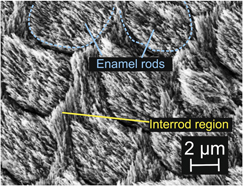Crossref Citations
This article has been cited by the following publications. This list is generated based on data provided by
Crossref.
Jia, Yunfei
Xuan, Fu-Zhen
and
Yang, Fuqian
2013.
Analysis of the effect of a compliant layer on indentation of an elastic material.
Journal of the Mechanical Behavior of Biomedical Materials,
Vol. 25,
Issue. ,
p.
33.
Yilmaz, Ezgi D.
Bechtle, Sabine
Özcoban, Hüseyin
Schreyer, Andreas
and
Schneider, Gerold A.
2013.
Fracture behavior of hydroxyapatite nanofibers in dental enamel under micropillar compression.
Scripta Materialia,
Vol. 68,
Issue. 6,
p.
404.
Sui, Tan
Sandholzer, Michael A.
Baimpas, Nikolaos
Dolbnya, Igor P.
Landini, Gabriel
and
Korsunsky, Alexander M.
2013.
Hierarchical modelling of elastic behaviour of human enamel based on synchrotron diffraction characterisation.
Journal of Structural Biology,
Vol. 184,
Issue. 2,
p.
136.
Jia, Yunfei
Xuan, Fu-Zhen
and
Yang, Fuqian
2014.
Finite element analysis of depth effect on measuring elastic modulus of a core-shell structure for application of instrumented indentation in tooth enamel.
Materials Science and Engineering: C,
Vol. 37,
Issue. ,
p.
84.
Sui, Tan
and
Korsunsky, Alexander M.
2014.
Advanced Healthcare Materials.
p.
237.
Jia, Yunfei
Xuan, Fu-zhen
Chen, Xiaoping
and
Yang, Fuqian
2014.
Finite element analysis of the cyclic indentation of bilayer enamel.
Journal of Physics D: Applied Physics,
Vol. 47,
Issue. 17,
p.
175401.
Sui, Tan
Lunt, Alexander J.G.
Baimpas, Nikolaos
Sandholzer, Michael A.
Hu, Jianan
Dolbnya, Igor P.
Landini, Gabriel
and
Korsunsky, Alexander M.
2014.
Hierarchical modelling of in situ elastic deformation of human enamel based on photoelastic and diffraction analysis of stresses and strains.
Acta Biomaterialia,
Vol. 10,
Issue. 1,
p.
343.
Jia, Yunfei
Xuan, Fu-Zhen
and
Yang, Fuqian
2015.
Viscoplastic response of tooth enamel under cyclic microindentation.
Materials Science and Engineering: C,
Vol. 55,
Issue. ,
p.
448.
Dreyer, Axel
Feld, Artur
Kornowski, Andreas
Yilmaz, Ezgi D.
Noei, Heshmat
Meyer, Andreas
Krekeler, Tobias
Jiao, Chengge
Stierle, Andreas
Abetz, Volker
Weller, Horst
and
Schneider, Gerold A.
2016.
Organically linked iron oxide nanoparticle supercrystals with exceptional isotropic mechanical properties.
Nature Materials,
Vol. 15,
Issue. 5,
p.
522.
Liu, Tao
Deng, Qiang
Yang, Dan
Zheng, Jing
Liu, JianTao
and
Zhou, ZhongRong
2017.
Automatic modeling together with numerical simulation of the different-scale microstructures of human tooth enamels.
Science China Technological Sciences,
Vol. 60,
Issue. 9,
p.
1381.
Rathsam, Catherine
Farahani, Ramin M.
Hains, Peter G.
Valova, Valentina A.
Charadram, Nattida
Zoellner, Hans
Swain, Michael
and
Hunter, Neil
2018.
Characterization of inter-crystallite peptides in human enamel rods reveals contribution by the Y allele of amelogenin.
Journal of Structural Biology,
Vol. 204,
Issue. 1,
p.
26.
Yilmaz, Ezgi D.
Koldehoff, Jasmin
and
Schneider, Gerold A.
2018.
On the systematic documentation of the structural characteristics of bovine enamel: A critic to the protein sheath concept.
Dental Materials,
Vol. 34,
Issue. 10,
p.
1518.
Sui, Tan
Salvati, Enrico
Harper, Robert A.
Zhang, Hongjia
Shelton, Richard M.
Landini, Gabriel
and
Korsunsky, Alexander M.
2018.
In situ monitoring and analysis of enamel demineralisation using synchrotron X-ray scattering.
Acta Biomaterialia,
Vol. 77,
Issue. ,
p.
333.
DENG, QIANG
ZONG, ZHIFANG
NING, ZHENWU
ZHENG, JING
LIU, JIANTAO
and
ZHOU, ZHONGRONG
2018.
A COMPUTATIONAL STRATEGY TO EXAMINE THE PROFILE EFFECTS OF MICROPRISM REGIONS ON THE OVERALL ANISOTROPY OF HUMAN ENAMELS.
Journal of Mechanics in Medicine and Biology,
Vol. 18,
Issue. 03,
p.
1850027.
Beniash, Elia
Stifler, Cayla A.
Sun, Chang-Yu
Jung, Gang Seob
Qin, Zhao
Buehler, Markus J.
and
Gilbert, Pupa U. P. A.
2019.
The hidden structure of human enamel.
Nature Communications,
Vol. 10,
Issue. 1,
Yang, Y.
Yang, D.
and
He, Q.-C.
2019.
Investigation of the effective wear of enamel accounting for microstructure and phase properties.
Wear,
Vol. 432-433,
Issue. ,
p.
202941.
Stifler, Cayla A.
Jakes, Joseph E.
North, Jamie D.
Green, Daniel R.
Weaver, James C.
and
Gilbert, Pupa U.P.A.
2021.
Crystal misorientation correlates with hardness in tooth enamels.
Acta Biomaterialia,
Vol. 120,
Issue. ,
p.
124.
Peng, Jiapin
Xiao, Heng
Lei, Lei
Yang, Dan
Zheng, Jing
and
Zhou, Zhongrong
2022.
Heterogeneous hardening of enamel surface by occlusal loading: Effect of nanofiber orientation.
Journal of the Mechanical Behavior of Biomedical Materials,
Vol. 130,
Issue. ,
p.
105221.
2023.
Origini, forma e (dis)funzioni dell’apparato masticatorio in Homo sapiens .
Vol. 253,
Issue. ,
Towle, Ian
Loho, Thomas
Salem, Amira Samir
Berthaume, Michael A.
and
Loch, Carolina
2023.
Variation in enamel mechanical properties throughout the crown in catarrhine primates.
Journal of Human Evolution,
Vol. 182,
Issue. ,
p.
103413.





